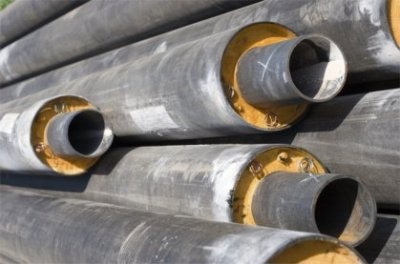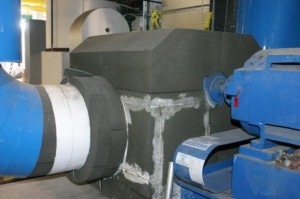Thermal insulation is an important feature when developing or maintaining hot-oil systems. However, sufficient insulation in such systems comes with certain advantages and disadvantages.
Even if energy costs are ignored, a high level of protection would still have to be provided to company workers, who are constantly exposed to hot pipes. Besides this exposure, large ventilation fans are used in the heater room to ensure that the control panel does not melt.
Auto-Ignition Fire Hazards
In the case of heat transfer fluids based on hydrocarbons, certain insulating issues are encountered. For instance, fluids leaking into the thermal insulation can pose a major fire risk, and these fluids will be partially oxidized to form an entirely different material.
This oxidization takes place when there is limited supply of fresh air and also fluids are continuously exposed to high temperature within the insulation. Figure 1 shows steel pipes insulated for hot water.

Figure 1. Steel pipes insulated for hot water.
Auto-ignition can occur in two sets of conditions - when rearrangement of molecules creates a compound that catches fire at the temperature and oxygen levels within the material, or when a rapid increase in oxygen level occurs. Clearly, both of these situations represent a real hazard.
Controlling Fire Hazard from Insulation
Several methods can be used to reduce fire hazards from insulation. Insulation merely constitutes several air pockets, which are kept in place by a special material. In the case of high-temperature systems, these types of materials can include compressed particles such as perlite and calcium silicate, mineral fibers, or cellular glass like FOAMGLAS® Insulation (Figure 2).

Figure 2. Pittsburgh-Corning FOAMGLAS® insulation before coating/cladding.
This material is created in such a way that air pockets in the cellular glass material are not joined together. This way, any fluid entering the material will remain separated close to the leak point, thereby avoiding auto-ignition that leads to fires.
The material is typically drilled with weep holes, so that the heat transfer fluid that gets accumulated can easily drain out, thereby reducing fire hazards. However, if the drain is located directly over an ignition source, this will also cause a fire.
Cellular glass is a rigid material, and hence needs to be purchased in shapes or blocks to accommodate particular parts such a piping Ts, valves, etc. However, this tends to increase the material cost, and since onsite cutting is also needed to accommodate one rigid part to another, installation costs also become higher.
Reducing Insulation Fire Potential While Controlling Cost
FOAMGLAS® is a high-quality cellular glass insulation that is capable of preventing potential insulation fires. However, this product proves more expensive in terms of price and installation when compared to compressed particle-type materials or mineral fibers like glass wool or fiber glass.
One way to optimize this high insulation cost is to use less costly material where there is a reduced possibility of fluid leaks, and use cellular glass where it is highly required. However, care should be taken to ensure that there is no leakage on an uninterrupted pipe run, or else this will lead to even bigger problems.
Standard high-potential leak regions comprise Y strainers, valves, and other connections and pressure taps where fluid can possibly leak. Calcium silicate or fiber glass can be used in all these areas.
Transitions from One Type of Insulation to Another are Critical
Horizontal pipe runs can generally change either at flanges or at 12 to 18” from the leak point. If users want to keep the cladding intact, then they should maintain at least 1 to 2” space between the flange and the insulation, so that the bolts can be tightened again as soon as the instrument is set at working temperature.
The insulation has an open end, which must be closed to eliminate spills from above and thus, prevent heat transfer fluids from entering the material. Where transitions take place on vertical pipe runs, extra care must be taken to seal the end properly, because any leakage will pass along the length of the pipe under the cellular glass.
In the case of short vertical runs, optimization of the insulation may involve skipping the transition till the horizontal pipe run begins, and where it is not as critical to seal the open end.
Flanges should not be insulated in hot oil systems, but if a non-insulated flange compromises the safety aspect, then a protective sheet-metal cover with a drainage hole should be installed. Modular insulation or cladding systems are also available, which are non-permeable and removable, and hence can be installed across the flanges. These systems can also be used on Y-strainers and valves.
Table 1 shows the thickness of insulation, heat loss, and savings for divergent sizes of pipes at 500°F.
Table 1. Insulation thickness, heat loss, and savings for varied pipe sizes at 500°F
| Nominal Pipe Size (Inches) |
Insulation Thickness (Inches) |
Surface Temp °F |
Heal Loss (BTU/ft/yr) |
Efficiency % |
Energy Cost ($/ft/yr) |
Saving over bare pipe ($/ft/yr) |
| 2 |
Bare |
499.2 |
8730000 |
|
113.4 |
|
| 2 |
1.5 |
124.6 |
1150000 |
86.85 |
14.92 |
98.48 |
| 3 |
1.5 |
129.5 |
1520000 |
87.96 |
19.7 |
143.9 |
| 4 |
1.5 |
131.9 |
1830000 |
88.59 |
23.72 |
184.2 |
| 5 |
1.5 |
135.6 |
2220000 |
88.67 |
28.86 |
225.8 |
| 10 |
1.5 |
137.3 |
3660000 |
90.11 |
47.59 |
433.4 |
| 20 |
2 |
130.4 |
5360000 |
92.11 |
69.63 |
812.5 |
While it is easy to control fire hazards resulting from insulation, the materials used can prove to be more costly when compared to traditional insulation materials. As soon as the system is running efficiently, the insulation must be checked from time to time, so that fluid does not leak into the material.
If there is odor or smoke relating to hot fluid, this should be checked thoroughly. The cladding can be drilled with weep holes, so that the leaked fluid can easily drain out.
Darkening of the cladding or insulation indicates that fluid is leaking. Fluid-soaked insulation should be carefully taken out because any spontaneous increase in the oxygen level can cause auto-ignition.
Conclusion
Paratherm | Heat Transfer Fluids | Hot-Oil Technology Made Easy
The aforementioned recommendations provide adequate insulation for hot oil systems and thus, can effectively prevent non-combustible insulation materials from becoming a fire hazard.

This information has been sourced, reviewed and adapted from materials provided by Paratherm.
For more information on this source, please visit Paratherm.